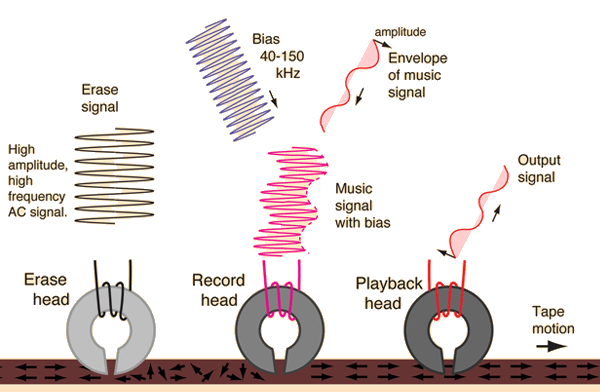Tape Recording Process

Sound reproduction concepts
Tape recording concepts
Reference
Rossing
Science of Sound
Ch 21
| HyperPhysics***** Sound | R Nave |
Tape Recording Process |
Index Sound reproduction concepts Tape recording concepts Reference Rossing Science of Sound Ch 21 | ||
|
Go Back |
Erase Head
|
Index Sound reproduction concepts Tape recording concepts Reference Rossing Science of Sound Ch 21 | |||
|
Go Back |
A magnetic "image" of a sound signal can be stored on tape in the form of magnetized iron oxide or chromium dioxide granules in a magnetic emulsion. The tiny granules are fixed on a polyester film base, but the direction and extent of their magnetization can be changed to record an input signal from a tape head.
|
Index Sound reproduction concepts Tape recording concepts Reference Rossing Science of Sound Ch 21 | |||
|
Go Back |
Tape Playback
Problem: The magnetization of the magnetic emulsion is proportional to the recorded signal while the induced voltage in the coil is proportional to the rate at which the magnetization in the coil changes. This means that for a signal with twice the frequency, the output signal is twice as great for the same degree of magnetization of the tape. It is therefore necessary to compensate for this increase in signal to keep high frequencies from being boosted by a factor of two for each octave increase in pitch. This compensation process is called equalization.
|
Index Sound reproduction concepts Tape recording concepts Reference Rossing Science of Sound Ch 21 | |||
|
Go Back |